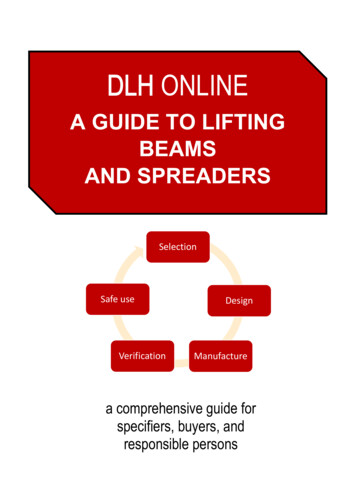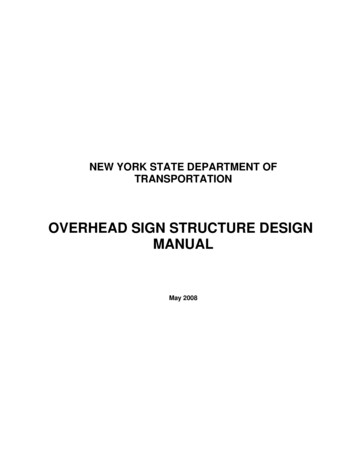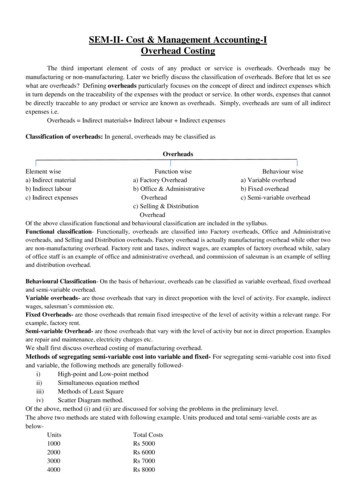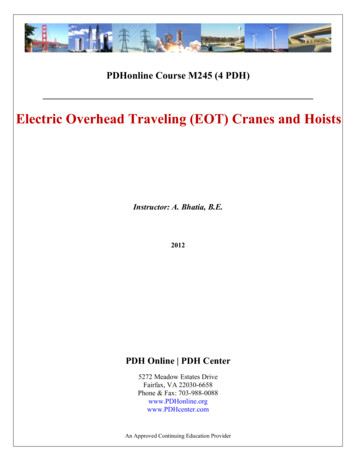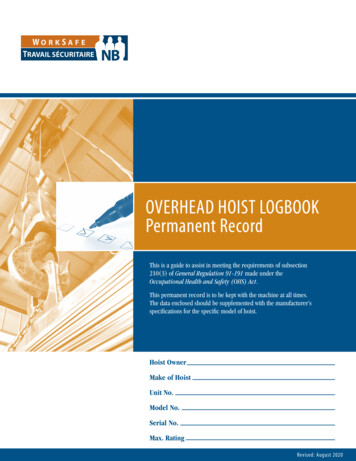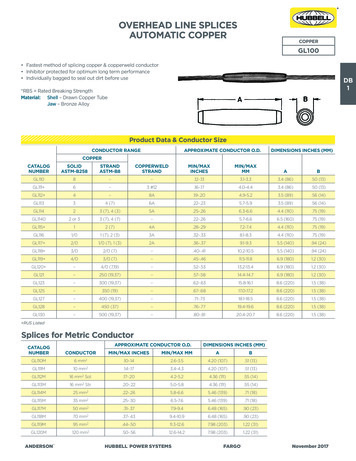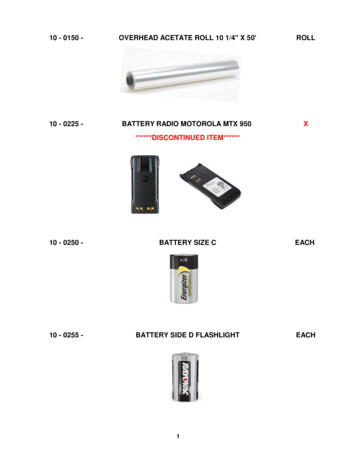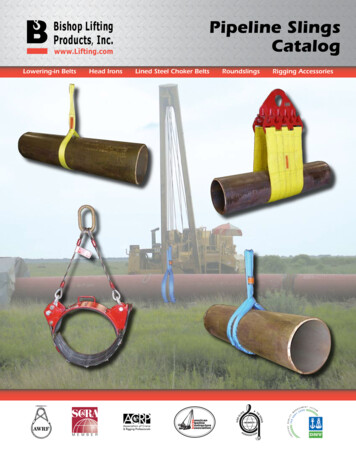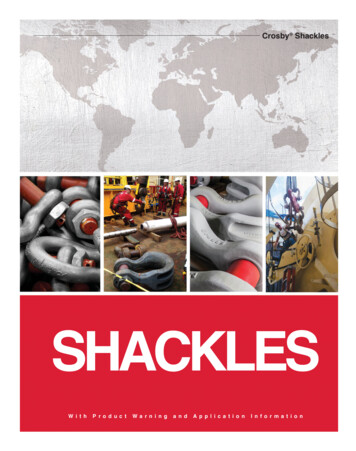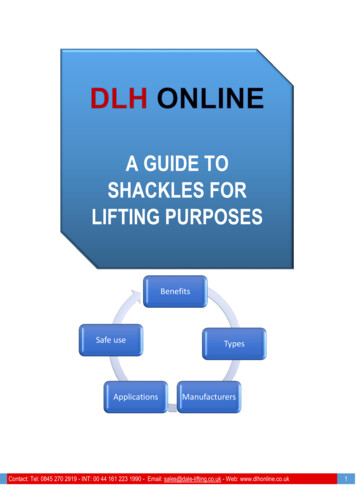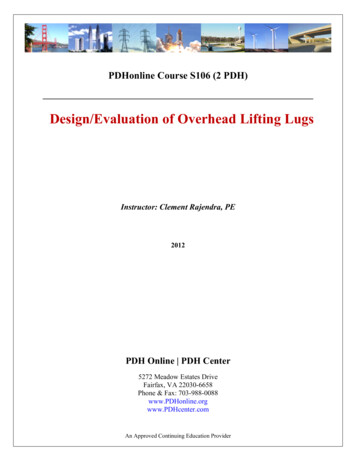
Transcription
PDHonline Course S106 (2 PDH)Design/Evaluation of Overhead Lifting LugsInstructor: Clement Rajendra, PE2012PDH Online PDH Center5272 Meadow Estates DriveFairfax, VA 22030-6658Phone & Fax: 703-988-0088www.PDHonline.orgwww.PDHcenter.comAn Approved Continuing Education Provider
Design/Evalutionof Overhead Lifting LugsPage 1DISCLAIMER: The materials contained in this MathCad file are not intended as a representation or warrantyon the part of PDHonline.org or any other person named herein. The materials are for general informationonly. They are not a substitute for competent professional advice. Application of this information to a specificproject should be reviewed by registered professional engineer. Anyone making use of the information setforth herein does so at their own risk and assumes any and all resulting liability arising therefrom.Design/Evaluation ofOverhead Lifting Lugsby Clement Rajendra, PEProject Engineer, CP&L, Southport, NC 28461e-mail: clem.rajendra@pgnmail.comIntroductionThere is very little published information available on the subject of the design/analysis oflifting lugs. Therefore, design engineers are left without adequate technical guidance onthis subject. The following provides a systematic method.Example of an Overhead Lifting LugEmbedplatethickness, tkip 1000 lbt : 1.25 inDia. dksi 1000 lbin ind : 1.25 in2”a : 1.125 in1/2”e1.75”ae : 1.125 inFu : 58 ksi3.5”Fy : 36 ksiGeometric Guidelines:There are some geometric guidelines to be considered as recommendedin Reference 1. They will be called Rule 1 and Rule 2.Rule 1:The dimension "a" must be greater than or equal to half the holediameter, d.i.e. a 1/2 * dFor this example, a 1.125" and since it is greater than 1/2*d which is0.625". Rule 1 is satisfied.Rule 1 : if ( a 0.5 d , "OK" , "NG" )Rule 1 "OK"
Design/Evalutionof Overhead Lifting LugsPage 2Rule 2:The dimension "e" must be greater than or equal to 0.67 times the holediameter, d.Thus, e 0.67 * dFor this example, e 1.125" and since it is greater than 0.67*d which is0.8375". Rule 2 is satisfied.Rule 2 : if ( e 0.67 d , "OK" , "NG" )Rule 2 "OK"Evaluation based on Failure Modes:Failure Mode 1:This failure mode involves tension failure on both sides of the hole. Therefore, the ultimatetensile load is given by:Pu : 2 a t FuPu 163.12 kipA factor of safety of 5 is common for lifting components. Therefore, using afactor of safety of 5, the working load is:Pw1 : PuPw1 32.625 kip5Failure Mode 2:This failure mode involves bearing failure at the pin/lifting lug interface. Often the pindiameter is much less than the hole diameter. Let us assume a pin diameter 1/2" less thanthe hole diameter. Using a bearing stress of 0.9 Fy , and a "factor" of 1.8, we have (SeeNote 1):dpin : d 0.50 inPw2 : 0.9 Fy t dpin1.8Pw2 16.875 kip
Design/Evalutionof Overhead Lifting LugsFailure Mode 3:This failure mode involves shear failure as the pin tries to push out a block of steel throughthe edge of the lug plate. The shear area is twice the cross-sectional area beyond the holefor the pin. Thus:Pw3 : 2 0.4 Fy e t1.8Pw3 22.5 kipFailure Mode 4:This failure mode involves tensile failure as the pin tries to push out a block of steel throughthe edge of the lug plate. Assuming a block of steel 0.8d in length, allowable load is givenby:21.67 0.67 Fy e Pw4 : td1.8Pw4 28.322 kipFailure Mode 5:This failure mode involves the out-of-plane buckling failure of the lug. Per Ref. 1, this failureis prevented by ensuring a minimum thickness of lug of 0.5 inches and 0.25 times the holediameter d.In this example, since 0.25 x 1.25 0.3125" and the thickness of the lug is 1.25",this failure mode does not control.Rule 3 : if ( t 0.25 d , "OK" , "NG" )Rule 3 "OK"Rule 4 : if ( t 0.5 in , "OK" , "NG" )Rule 4 "OK"Page 3
Design/Evalutionof Overhead Lifting LugsPage 4AISC Code Checks per Section D3.2:The above section of AISC Code has three separate geometry checks that can be appliedto the lifting lug. If these requirements are not met, a smaller value for "a"should be used for the calculation of tensile capacity, aeff.Requirement 1:This requirement states that the minimum net area beyond the pin hole, parallel to the axisof the member (A1), shall not be less than 2/3 of the net area across the pin hole(A2).A1 : t eA2 : 2 a t2A1 1.406 in2A2 2.813 inSince 2/3 of A2 is 1.875 in2 which is more than A1, this requirement is not satisfied.Therefore, the tensile capacity of the lug must be based on a reduced "a" dimensionwhich will satisfy this requirement.Requirement 2:This requirement states that the distance transverse to the axis of a pin-connected platefrom the edge of the pin hole to the edge of the member, i.e. dimension a, shall not exceed4 times the thickness at the pin hole.Since 4 times thickness is 4 x 1.25" 5" and is greater than 1.125". This requirement issatisfied.Requirement 3:This requirement states that the diameter of the pin hole shall not be less than 1.25 timesdistance from the edge of pin hole to the edge of plate, i.e. dimension a.Since 1.25 times "a" is 1.25 x 1.125 1.406" and is greater than the diameter of hole of1.25". This requirement is not satisfied. Therefore, the tensile capacity of the lug mustbe based on a reduced "a" dimension which will satisfy this requirement.Combining these three requirements into a single "formula" we have: e 2AISCmin : a 1.5 4 t 1.25 aeff : min( AISCmin)Therefore, load capacity based on AISC is given by:Pw5 : 2 aeff 0.45 Fy t1.8Pw5 18.984 kipd
Design/Evalutionof Overhead Lifting LugsPage 5Weld between Lug and Base Plate:This is typically the weak link in an overhead lifitng lug, due to off-set loading. In general,the lug is rarely directly over the item to be rigged. Conservatively, let us assume that theoff-set is a maximum of 45 degrees in the plane of the lug and 20 degrees normal to theplane of the lug. The additional loads due to off-set can be determined by statics to be asfollows:αW tan αdegβW tan βdegWWTherefore, the maximum load W that can be applied can be calculated as follows:W : 1 kipThis is an initial guess for Mathcadtw : 1.25 inLength of welds along lug thicknessl : 2 inLever armw : 3.5 inLength of weld along lug width7423 lbfmax : 1.8 infor 1/2 in. fillet weld and 21 ksiallowable shear stress oneffective throatf1 ( W) : WW tan ( β deg) l W tan ( α deg) l 22 ( w tw) 2 tw w w t w w tw 3 3 α : 45β : 20Based on Ref. 3
Design/Evalutionof Overhead Lifting Lugsf2 ( W) : W tan ( β deg)2 ( w tw)f3 ( W) : W tan ( α deg)2 ( w tw) 222 0.5Pw6 : root f1 ( W) f2 ( W) f3 ( W) fmax , W Pw6 8.198 kipLug Base Material:The analysis is similar to the weld above except that there is no interaction between tensionand shear. The capacity is based on the maximum tensile stress at the base of the lug:W : 1 kipfmax : 0.75 Fy1.8lw : 2 a df1 ( W) : Lug widthW W tan ( β deg) l W tan ( α deg) l t2 l 2 lw t w l w t 6 6 Pw7 : root ( f1 ( W) ) fmax , W Pw7 8.283 kipPage 6
Design/Evalutionof Overhead Lifting LugsPage 7Conclusion:Capacity : (Pw1 Pw2 Pw3 Pw4 Pw5 Pw6 Pw7)Capallow : min( Capacity)Capallow 8.198 kipNote variation in capacities for each attributePw1 32.625 kipPw4 28.322 kipPw2 16.875 kipPw5 18.984 kipPw3 22.5 kipPw6 8.198 kipPw7 8.283 kipIf additional capacity is desired, the angles α and β can be restricted as needed to increase thecapacity of the lug. In the above example, if these angles are made equal to zero, the maximumcapacity will increase to 16.875 kips.References:1. David T. Ricker, "Design and Construction of Lifting Beams", Engineering Journal, 4th Quarter, 1991.2. AISC Manual of Steel Construction (ASD), Ninth Edition, 19893. Omer Blodgett, "Design of Welded Structures", 1966Notes:1. As discussed in Reference 1, using a "factor" of 1.8 on AISC allowables results in a factor of safetyof 5 for A36 steel. This is in line with ASME B30.20 which requires a design factor of 3 on yieldstrength and ANSI N14.6 which requires a design factor of 3 on yield strength and 5 on ultimatestrength. This is also in line with the load ratings for other components of the lifting assembly such asslings, shackles, etc.
Design/Evalution of Overhead Lifting Lugs Page 2 Pw2 16.875kip Pw2 0.9 Fy t dpin 1.8: dpin : d 0.50 in This failure mode involves bearing failure at the pin/lifting lug interface. Often the pin diameter is much less than the hole diameter. Let us assume a pin diameter 1/2" less than the hole diameter.File Size: 243KBPage Count: 8
